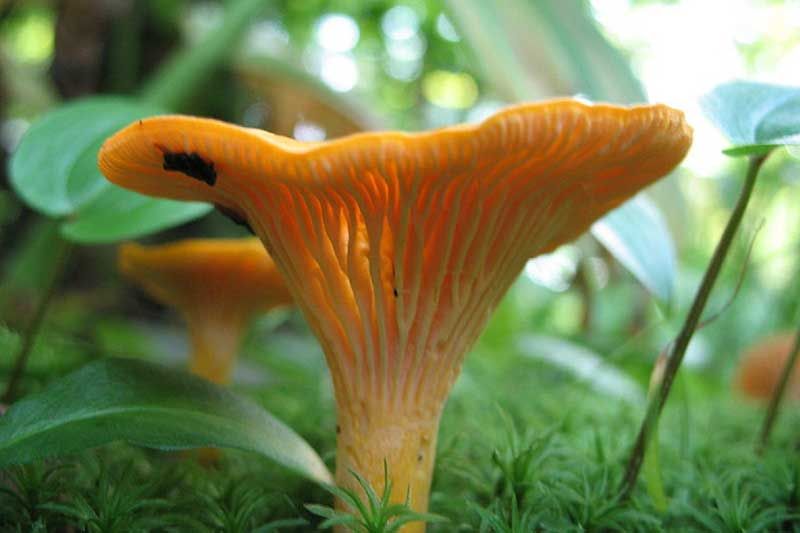Steve Blight | Aug 07, 2013
By Steve Blight
It’s early August and the first signs of late summer have started to emerge. The dawn chorus of birdsong is fainter, the goldenrod is starting to flower, and it may be my imagination but the chirping of the crickets seems to be a little more insistent. While it’s true that as summer progresses the woods and fields seem a little quieter, there are some things getting ready for their big show. Some mushrooms appear in the spring, like morels, but late summer and fall is the big show for mushrooms.
A couple of weeks ago I was reading that with all the rain this year, mushrooms had begun to pop up in good numbers. In particular I read that chanterelles were putting on a good show. As many people may know, chanterelles (usually known as Golden Chanterelles) are a choice edible mushroom that is widespread across North America, including in our area. So I did a little research to figure out what they look like and off I went one morning into the woods to see what I could find.
In all honesty, my expectations were low. Over time I have acquired reasonable skills at identifying things in nature, but I felt like this was a hunt for the proverbial needle in the haystack. If nothing else, it gave me a good excuse to go for a long, leisurely walk in the woods with the dog. But imagine my surprise that within 10 to 15 minutes, I spotted something that could be chanterelles. Egg-yolk yellow, trumpet shaped, growing singly out of the ground and not on rotting wood, a couple of inches tall, and with gill-like wrinkles on the underside. All the preliminary field checks were there. So I harvested about a half dozen and took them home for some serious research.
Before I continue, I need to provide some very important words of caution – should readers find themselves interested in harvesting wild mushrooms to eat, please be very careful! Many choice edible mushrooms have look-alikes that can give a nasty bout of stomach illness or worse. Some are downright dangerous – a number of species in the Amanita genus really are deadly poisonous. Be absolutely certain before eating wild mushrooms – there is a very wise adage in the mushrooming business – “if in doubt, throw it out”. With respect to chanterelles (Cantharellus cibarius), there are at least two species of mushrooms that could be confused with chanterelles – the false chanterelle (Hygrophoropsis aurantiaca), and the Jack O’Lantern mushroom (Omphalotus illudens). Both of these mushrooms have true gills and a bunch of other differences, but superficially resemble chanterelles. From my reading, both can have bad effects on people, but it appears that the Jack O’Lanterns are the nastier of the look-alikes
Back home, I examined my finds very carefully, checking outside colour, inside colour, smell, cap shape, cap edge characteristics, stem shape. Of particular importance was a close examination of the “false” gils. It turns out that chanterelles do not have true spore-producing gills – rather they have thicker wrinkle-like structures that superficially resemble gills but are different. After convincing myself that these were indeed chanterelles, I cut one small one up and sautéed it in olive oil, and after adding a little salt and pepper, I gingerly tasted one piece. It was delicious. I shared one piece with my wife Anna who accepted it with markedly little enthusiasm. Then I ate the rest of the cooked mushroom, and we waited to see if anything bad would happen. Nothing. The next day, I cleaned up the rest of the chanterelles, cooked them with scrambled eggs and chives and my wife and I had a delicious breakfast, partially harvested from the wild on our own property. My daughter Elizabeth wanted absolutely nothing to do with this activity. In her mind, hunting for and consuming wild mushrooms meant that I had crossed over the invisible line from being slightly odd to becoming a total geek. A week later I went back to the patches I had found and harvested a few more chanterelles that had popped up during the week. Equally delicious, I am happy to report.
There are other edible mushrooms growing in the forests of our area. Over time, I’d like to add to the repertoire of mushrooms that I can confidently harvest from the wild, but I intend to approach each new species with caution and build my list very slowly and carefully. Collecting wild mushrooms brings new and important meaning to the saying “better safe than sorry”!
Please feel free to report any observations to Lorraine Julien at This email address is being protected from spambots. You need JavaScript enabled to view it. or Steve Blight at This email address is being protected from spambots. You need JavaScript enabled to view it.
More Stories
- Province clarifies stance - Says Private Well Water Testing Will Continue
- Frontenac County Stays Internal for CAO - Appoints Kevin Farrell
- Addington Highlands Tax Bill Going Up 6.93%
- Perth Road United Church Donation to The Grace Centre
- 21 Years Of Dump Life Left At South Frontenac Waste Site
- Eclipse 2024 – Once In A Lifetime
- National Tourism Week
- NeLL Spring Open House and Anniversary Concert
- 25 years at Bishop Lake Outdoor Centre
- Grounds Contracts Down, Custodial Contracts Up In Central Frontenac

